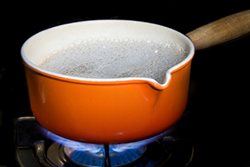
In a report recently released by the Saint Francis Memorial Hospital, it was noted that hot liquids are the leading cause of scalding injuries in children under four years old.
According to another study by the Consumer Product Safety Commission, there are approximately 5,000 people treated in emergency rooms each year in the United States due to scalding accidents alone – with over 25% of these victims requiring an overnight stay in the treatment center.
As with many burns-related injuries, unfortunately children and the elderly are often most at risk. Over 85% of these injuries occur to children and young adults that are under the age of 15, or to senior citizens that are over 65 years old.
Quick Scalding Facts
Burns and scalds by hot liquids usually occur when people are in a hurry, or under a time constraint of some nature. Some common facts about scalding injuries include:
- hot tap water accounts for approximately 17% of hospitalizations in children
- a third degree burn can occur in just five seconds if the water temperature is only 140 degrees
- hot beverages (including tea, soup & coffee) are often hot enough to provide a serious scalding injury
- steam is often a contributing factor in scalding cases
If you or a loved one has been scalded it is important to immediately seek the services of a skilled medical practitioner. They have the tools and knowledge in how to best treat a burn injury, and to help minimize the suffering of the victim.
Hot Water And The Human Skin
Hot water is known to cause burns to skin in various “degrees”. The most serious is known as a “third degree” burn and is referred to as a “full thickness burn”. What this means is that the outer layer of skin (the epidermis) and the entire layer beneath (the dermis) is completely destroyed.
Third degree burns “wet burns” (caused by liquids) can happen in:
- 1 second at 156 degrees F
- 2 seconds at 149 degrees F
- 5 seconds at 140 degrees F
- 15 seconds at 133 degrees F
This short time is largely a result of the human skin being only 3 mm thick, and thus very easy to burn.
Scald Injury Prevention
It must also be noted that while scalding burn injuries are often very serious personal injuries, they are preventable.
In many cases, scalds caused by hot water were simply due to water heater thermostats being set too high, or of there being a lack of functioning pressure and temperature sensing valves at the source of the hot water. These can all be fixed by an approved, certified plumber, who will fix the problem in compliance with the three main U.S Plumbing Codes (Int’l Plumbing Code, Uniform Plumbing Code and Standard Plumbing Code).
These codes essentially state that water shall not be delivered in a place of residence above a maximum temperature of 120 degrees Fahrenheit.
Another simple way to prevent scalding injuries – especially around children – is to ensure that any hot liquids are kept securely on counters and stove tops, and that all pot and pan handles are pointed towards the nearest back wall of the stove (away from the counter / stove edge).
What Can I Do If I Have Been Injured By Another Person?
Serious scalding injuries can present a multitude of problems. Aside from the obvious pain and suffering, other factors like medical costs, loss of wages, medication costs and on-going treatment all need to be accounted for. If an adult is injured, they risk losing their job if they are incapacitated for any given period of time.
With this in mind, if you have received a scalding injury due to the negligence of another, you may have grounds to file a personal injury lawsuit .
At Gordon & Partners, we have over 180 years of combined legal experience in handling personal injury and other lawsuits for people and families just like you.
We have a proud history of representing people and not the powerful. With offices in Palm Beach Gardens, Pembroke Pines and Stuart, we service most of South Florida and can help you today.
To find out more, simply contact us on 1 (855) 722-2552 and we can explain how we can provide legal assistance in your situation.
Alternatively, fill out the “Free Case Evaluation” form on this page – it’s FREE!

 1-855-722-2552
1-855-722-2552